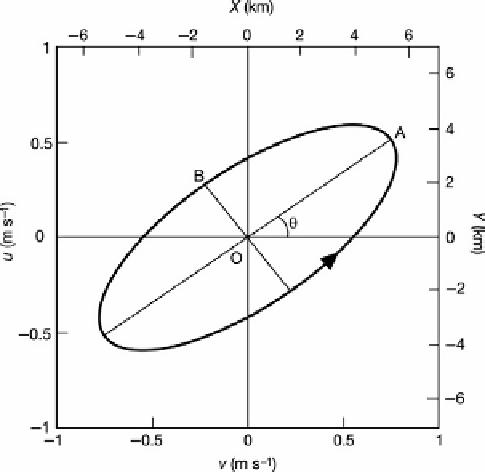Geoscience Reference
In-Depth Information
þ
v
Þ
The corresponding particle displacements are:
u
¼
u
M2
cos
ð
o
M2
t
þ
u
Þ;
v
¼
v
M2
cos
ð
o
M2
t
u
M2
o
M2
sin
v
M2
o
M2
sin
X
¼
ð
o
M2
t
þ
u
Þ;
Y
¼
ð
o
M2
t
þ
v
Þ:
Combining these sinusoidal displacements generates a particle trajectory which is
phases control both the orientation y and the shape of the ellipse which can vary from
a circular motion (clockwise or anticlockwise) to oscillation back and forth along a
straight line path (referred to as a 'degenerate ellipse'). The 'ellipticity' of the particle
trajectory is the ratio of the minor axis OB to the major axis OA with the convention
that positive/negative values correspond to anticlockwise/clockwise motion around
the elliptical path.
The term 'tidal ellipse' can be used to denote either the particle orbit, as described
above, or the locus of the tip of the velocity vector as at it rotates during the tidal
cycle since both have the same shape (see
Fig. B3.3
). Tidal ellipses can be defined
either by their constituent amplitudes and phases or alternatively by clockwise and
anticlockwise rotating components. Relations between the two forms of representa-
Figure B3.3
A tidal ellipse for
the M
2
tidal constituent
showing the major and minor
axes (OA and OB respectively)
and the orientation y. The
ellipse can be thought of as
representing the displacement
of a particle as shown on the
km scales (right and top) or the
track of the tip of velocity
vector in the u-v plane as shown
by the velocity scales (left and
bottom). In this case the
ellipse represents anticlockwise
motion with an ellipticity
of
þ
0.4.
3.6.5
Tidal resonance
It should be clear now that the effect of rotation is to transform each node of the
standing wave in the non-rotating case into an amphidrome. The amphidromic







Search WWH ::

Custom Search